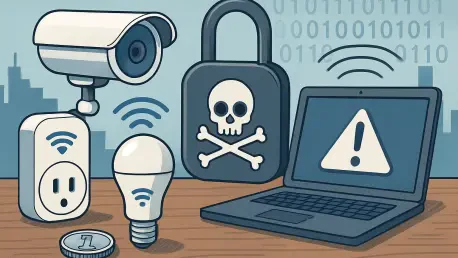Imagine walking into your home after a long day, only to realize that a stranger has remotely unlocked your smart lock without ever setting foot on your property, all because of a flaw in a budget-friendly device you trusted to keep your family safe. This chilling scenario is not mere speculation but a real risk uncovered by recent cybersecurity research. Inexpensive Internet of Things (IoT) devices, often marketed as convenient solutions for smart home management, are increasingly becoming gateways for potential breaches. With the proliferation of these low-cost gadgets, the balance between affordability and safety has come under scrutiny. While they promise ease and connectivity, the hidden vulnerabilities in their design can expose users to severe threats, turning a home’s protective systems into points of exploitation.
Uncovering Hidden Threats in Budget IoT Technology
Critical Flaws in Smart Home Hubs
Recent findings by cybersecurity experts have exposed alarming weaknesses in certain low-cost IoT hubs that serve as the backbone of many smart home setups. Specifically, a popular budget hub has been found to harbor multiple zero-day vulnerabilities—previously unknown flaws with no available fixes at the time of discovery. These issues, identified under several critical severity ratings, include an authorization bypass that lets attackers remotely manipulate devices like smart locks in other users’ homes. The predictability of device identifiers makes it disturbingly easy for malicious actors to target unsuspecting households. Beyond the immediate danger of unauthorized access, the implications are profound, as these hubs often control essential security components. This revelation underscores a troubling reality: devices meant to enhance safety can instead become tools for intrusion when cost-cutting compromises robust design.
Data Exposure Through Insecure Communication
Another significant concern lies in how these budget IoT devices handle sensitive information during transmission. Research has revealed that critical data, such as user credentials and Wi-Fi passwords, are often sent unencrypted over network protocols, leaving them vulnerable to interception by anyone with the right tools. This lack of basic encryption means that personal details can be captured in plain text, offering attackers a direct path to exploit not just the device but entire home networks. Such flaws are not mere technical oversights; they represent a systemic failure to prioritize security in the rush to deliver affordable products. For users, this translates to a heightened risk of privacy breaches, where even routine interactions with a smart device could inadvertently expose their most private information to unknown threats lurking on the same network.
Implications and Protective Measures for Homeowners
Immediate Risks to Physical Safety
The vulnerabilities in low-cost IoT devices extend far beyond digital threats, posing direct risks to physical security in homes relying on these systems for access control. When a central hub managing locks, garage door openers, and sensors is compromised, attackers can potentially gain entry to a residence without triggering any alarms. Cybersecurity analyses have demonstrated how such exploits can be executed remotely, often without the homeowner’s awareness until it’s too late. This breach of trust in devices marketed as security solutions highlights a critical flaw in the ecosystem of budget smart home technology. The absence of timely patches or manufacturer responses further exacerbates the danger, leaving users with few options to safeguard their properties against these sophisticated yet preventable attacks.
Steps to Mitigate Potential Dangers
In light of these unresolved security issues, taking proactive measures becomes essential for those using low-cost IoT devices in their homes. Experts strongly advise disconnecting vulnerable hubs from critical networks, especially those tied to entry points like doors or windows, until reliable fixes are issued by manufacturers. Exploring alternatives from vendors with a proven track record of delivering timely security updates is also recommended. Additionally, users should consider limiting the scope of connected devices to non-essential functions, reducing the potential impact of a breach. This situation serves as a stark reminder of the trade-offs involved in opting for cheaper technology, urging a reevaluation of priorities when it comes to protecting personal spaces. By reflecting on past oversights, consumers are encouraged to demand higher standards from manufacturers, ensuring that affordability no longer comes at the expense of safety.









